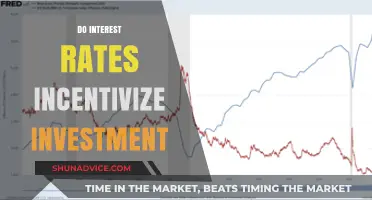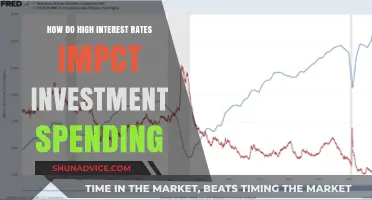
Understanding how to charge interest on investments is crucial for anyone looking to grow their money. Interest is essentially the cost of borrowing money, and when you lend your funds to others, you expect a return. This return is typically calculated as a percentage of the principal amount, known as the interest rate. The process involves assessing the risk and potential return associated with the investment, which then determines the interest rate charged. This rate can vary widely depending on factors such as the type of investment, the borrower's creditworthiness, and market conditions. It's a fundamental concept in finance, allowing individuals and businesses to make informed decisions about lending and borrowing, ensuring a fair and sustainable return on their investments.
What You'll Learn
- Interest Rates: Determine the rate based on market conditions and investment risk
- Compounding: Calculate future value with interest accumulation over time
- Loan-to-Value Ratio: Assess the ratio to set interest rates for investments
- Risk Premium: Charge extra for higher-risk investments to compensate for potential losses
- Interest Coverage Ratio: Measure a company's ability to pay interest with its earnings

Interest Rates: Determine the rate based on market conditions and investment risk
When determining interest rates for investments, it is crucial to consider both market conditions and the risk associated with the investment. Market conditions play a significant role in setting interest rates as they reflect the overall economic environment and the demand for credit. During periods of economic growth and low inflation, central banks often lower interest rates to encourage borrowing and stimulate economic activity. This can lead to lower interest rates on investments, making them more attractive to borrowers. Conversely, in times of economic downturn or high inflation, central banks may raise interest rates to curb borrowing and stabilize the economy. As a result, higher interest rates are typically applied to investments during these periods, making them less appealing to borrowers.
The risk associated with an investment is another critical factor in setting interest rates. Lenders and investors demand higher interest rates for investments that are considered riskier. This is because these investments carry a higher probability of default or loss. For example, loans to individuals with a history of late payments or those with lower credit scores will likely have higher interest rates compared to loans to individuals with a strong credit history and stable income. Similarly, investments in emerging markets or industries with a higher failure rate may also command higher interest rates due to the increased risk.
Market conditions and investment risk are interconnected. Market conditions can influence the perceived risk of an investment. For instance, during a market downturn, investments in certain sectors or industries may become riskier, leading to higher interest rates. Conversely, a strong market performance can make investments more attractive, potentially reducing interest rates. Additionally, the level of competition in the market can impact interest rates. In a highly competitive market, lenders may offer lower interest rates to attract borrowers, while in less competitive markets, interest rates might be higher due to limited alternatives.
To determine the appropriate interest rate, investors and lenders should conduct a thorough analysis of market conditions and assess the risk profile of the investment. This analysis should consider factors such as economic indicators, industry trends, and the specific characteristics of the investment. By understanding the market dynamics and the potential risks, investors can set interest rates that are competitive yet sustainable. It is essential to strike a balance between attracting borrowers and maintaining a healthy profit margin, ensuring the long-term viability of the investment.
In summary, setting interest rates for investments requires a comprehensive understanding of market conditions and the associated risks. Market conditions influence the overall demand for credit and the perceived risk of investments, while the risk associated with an investment directly impacts the interest rate demanded. By carefully evaluating these factors, investors can make informed decisions regarding interest rates, ensuring a fair and competitive lending environment while managing the potential risks involved.
Economic Growth, Lower Rates: The Investment Boost
You may want to see also

Compounding: Calculate future value with interest accumulation over time
Compounding is a powerful financial concept that demonstrates how interest can accumulate and grow over time, significantly impacting investment returns. It is the process by which interest is calculated on both the initial principal and the accumulated interest from previous periods, resulting in exponential growth. This phenomenon is a key factor in understanding the potential of long-term investments and the power of patience in the financial world.
To calculate the future value of an investment with compounding, you need to consider the principal amount, the interest rate, and the number of compounding periods. The formula for this calculation is: Future Value = P(1 + r/n)^(nt), where P is the principal, r is the annual interest rate, n is the number of times interest is compounded per year, and t is the number of years. This formula takes into account the periodic nature of compounding, ensuring that interest is earned on the growing balance.
For example, let's say you invest $10,000 at an annual interest rate of 5%, compounded annually. After 5 years, the future value of your investment can be calculated as follows: FV = $10,000 * (1 + 0.05/1)^(1*5) = $12,762.82. In this scenario, the interest earned in the first year is 5% of $10,000, which is $500. In the second year, the interest is calculated on the new balance of $10,500, and so on. This demonstrates how compounding can lead to substantial growth over time.
The impact of compounding becomes even more evident when considering longer investment periods and higher interest rates. For instance, investing for 10 years at 5% interest compounded annually would result in a future value of approximately $25,937.42, which is significantly higher than the simple interest calculation. This highlights the importance of understanding compounding to make informed investment decisions.
In summary, compounding is a critical aspect of investment strategies, allowing investors to harness the power of interest accumulation. By applying the compounding formula, investors can estimate the potential growth of their investments over time, making it an essential tool for financial planning and decision-making. It encourages investors to embrace long-term investment horizons and the potential for substantial returns.
Lower Interest Rates: Spending Boost or Investment Misstep?
You may want to see also

Loan-to-Value Ratio: Assess the ratio to set interest rates for investments
The Loan-to-Value (LTV) ratio is a critical metric used in the financial industry to assess the risk associated with lending and to set interest rates for investments. It is a simple yet powerful tool that provides insight into the potential value of an asset and the associated risk for the lender. The LTV ratio is calculated by dividing the loan amount by the appraised value of the property or asset being used as collateral. This ratio is an essential component in the lending process, especially for mortgage loans, as it helps lenders determine the level of risk they are taking on and set interest rates accordingly.
When evaluating an investment, the LTV ratio plays a pivotal role in risk management. Lenders use this ratio to assess the potential for default and the likelihood of recovery in the event of a borrower's inability to repay the loan. A higher LTV ratio indicates a larger loan amount relative to the value of the asset, which can be seen as a more significant risk for the lender. As a result, lenders often charge higher interest rates to compensate for this increased risk. For instance, a mortgage lender might offer a lower interest rate for a loan with an LTV of 70% compared to a loan with an LTV of 90%, as the higher LTV loan presents a greater potential loss in the event of default.
The assessment of the LTV ratio involves a thorough analysis of the asset's value and the loan amount. Appraisers and financial analysts use various methods to determine the appraised value, including comparable sales, cost approach, and income approach. Once the value is established, the loan amount is compared to this value to calculate the LTV ratio. This process ensures that lenders make informed decisions about the interest rates they charge, taking into account the specific risks associated with each investment.
In the context of investments, the LTV ratio provides a framework for lenders to strike a balance between risk and reward. By setting interest rates based on the LTV ratio, lenders can ensure that they are adequately compensated for the potential risks while also attracting borrowers who can afford the loan repayments. This approach promotes a healthy lending environment and contributes to the stability of the financial market.
In summary, the Loan-to-Value ratio is a vital tool for assessing the risk and setting interest rates for investments, particularly in the mortgage lending sector. It enables lenders to make informed decisions, manage risk effectively, and offer competitive interest rates that align with the potential value of the asset being used as collateral. Understanding and utilizing the LTV ratio is essential for anyone involved in the investment and lending process to ensure a robust and sustainable financial strategy.
Unveiling the Interest Rates: Are Investment Loans Worth the Cost?
You may want to see also

Risk Premium: Charge extra for higher-risk investments to compensate for potential losses
When dealing with investments, especially those with a higher risk profile, it is common practice to charge a risk premium to ensure that investors are adequately compensated for the potential risks they are taking. The risk premium is a financial charge that reflects the additional return investors demand to offset the uncertainty and potential losses associated with a particular investment. This concept is fundamental in the investment industry and plays a crucial role in attracting investors and managing investment portfolios.
In the context of charging interest for investments, the risk premium is a critical component. It is essentially a fee or a margin added to the interest rate to account for the risks involved. For instance, when lending money to a high-risk borrower, the lender would typically demand a higher interest rate, which includes the risk premium. This premium is a way to ensure that the lender's potential losses are covered and that the investment remains attractive to those seeking higher returns.
Calculating the risk premium involves assessing the specific risks of the investment. This includes analyzing factors such as the borrower's creditworthiness, the industry they operate in, market volatility, and any other relevant uncertainties. By evaluating these risks, financial institutions can determine the appropriate premium to charge. For example, if a company has a history of financial instability, the risk premium would be higher, reflecting the increased potential for losses.
The risk premium is a strategic tool for investment managers and lenders. It allows them to price investments fairly while also ensuring that the returns are aligned with the level of risk. This approach encourages investors to diversify their portfolios, as they can choose investments based on their risk tolerance and expected returns. In essence, the risk premium is a mechanism to balance risk and reward, making it an essential concept in the investment landscape.
In summary, charging a risk premium for higher-risk investments is a practical and necessary strategy in the financial industry. It ensures that investors are compensated for potential losses and encourages a more informed and cautious approach to investment decisions. By understanding and implementing this concept, investors and financial institutions can navigate the complex world of investments with greater confidence and success.
Robinhood's Interest Game: Unveiling the Truth Behind Investment Fees
You may want to see also

Interest Coverage Ratio: Measure a company's ability to pay interest with its earnings
The Interest Coverage Ratio is a financial metric that provides insight into a company's ability to manage its interest expenses relative to its earnings. It is a crucial indicator for investors and creditors, as it helps assess the company's financial health and its capacity to meet its debt obligations. This ratio is calculated by dividing a company's earnings before interest and taxes (EBIT) by its interest expense. The formula is as follows:
Interest Coverage Ratio = EBIT / Interest Expense
A higher interest coverage ratio indicates that the company generates more earnings per dollar of interest expense, suggesting a stronger financial position. For instance, if a company has an EBIT of $100,000 and an interest expense of $20,000, its interest coverage ratio would be 5. This means the company's earnings are sufficient to cover its interest payments five times over.
This ratio is particularly useful for investors when evaluating potential investment opportunities. It allows them to compare the financial strength of different companies, especially those with varying levels of debt. A higher ratio is generally preferred, as it indicates a lower risk of default on interest payments. For instance, an interest coverage ratio of 3 or higher is often considered a good benchmark, meaning the company's earnings are at least three times its interest expense.
However, it's important to note that the Interest Coverage Ratio should be analyzed in conjunction with other financial ratios and metrics. A single ratio might not provide a comprehensive view of a company's financial health. Other factors, such as the company's debt structure, cash flow, and industry trends, should also be considered.
In summary, the Interest Coverage Ratio is a valuable tool for assessing a company's capacity to manage its interest expenses. It provides a clear picture of the company's financial stability and its ability to generate sufficient earnings to cover its debt obligations. Investors and analysts can use this ratio to make informed decisions, ensuring that their investments are aligned with companies that demonstrate a strong ability to manage interest expenses.
Understanding Investment Interest Expense: How It Affects Adjusted Gross Income
You may want to see also
Frequently asked questions
The interest rate on investments is typically determined by a combination of factors, including the current market conditions, the creditworthiness of the borrower or issuer, and the term of the investment. It is influenced by various economic indicators and is often set by central banks or financial institutions.
Simple interest is calculated as a percentage of the principal amount, and it remains the same for the entire duration of the investment. Compound interest, on the other hand, is calculated based on the initial principal and the accumulated interest from previous periods. This means that the interest earned each period is added to the principal, and the subsequent interest is calculated on the new total.
Interest payment frequency varies depending on the type of investment. Some common payment schedules include annually, semi-annually, quarterly, or monthly. Fixed-income securities like bonds often have a specified payment schedule, while other investments may offer periodic distributions or allow interest to compound over time.







